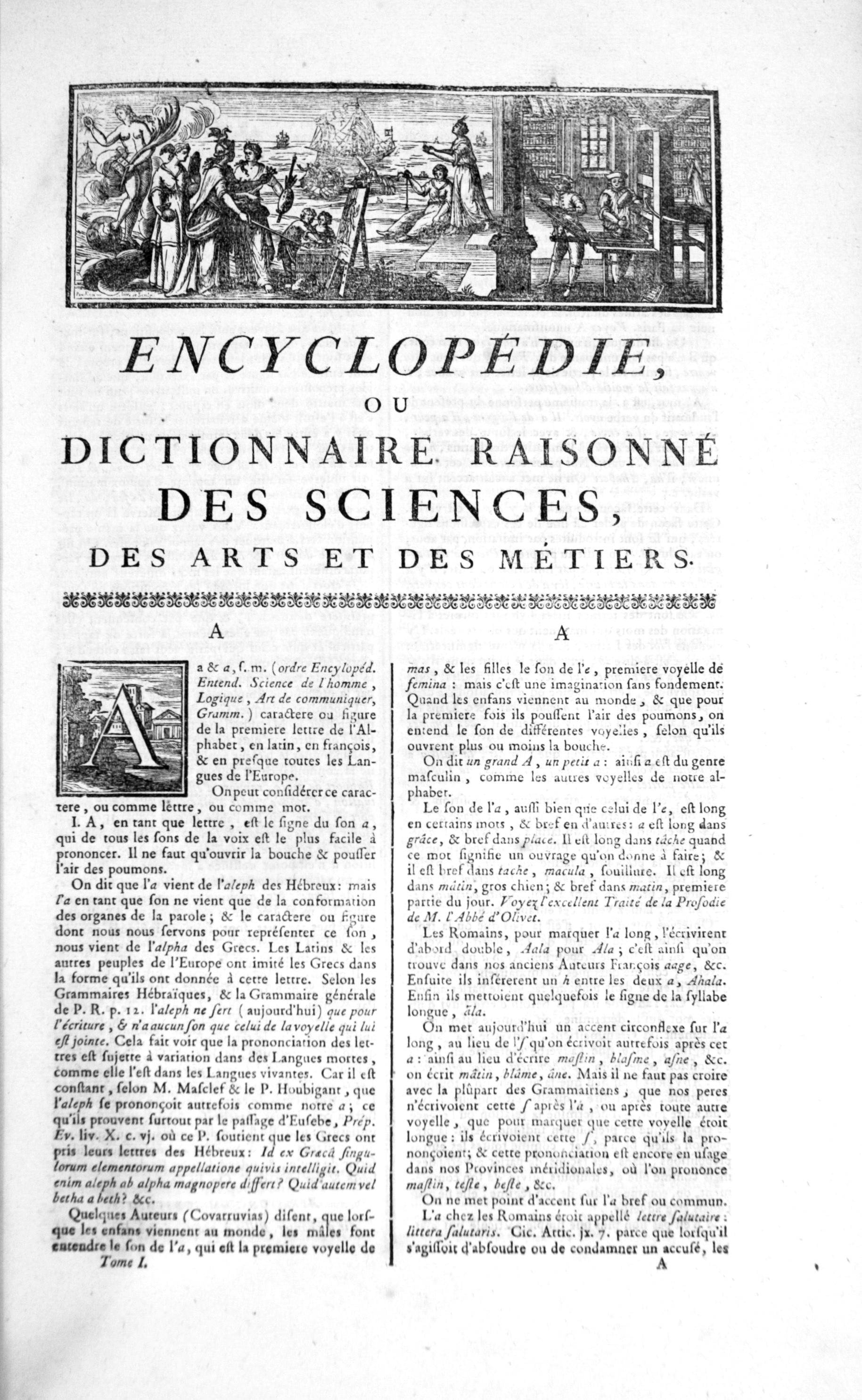Where does The Encyclopedia of the Migrants come from? Who is the person that sowed the seed of the project? What are its influences?
The first Encyclopédie, which inspired the name of our project, was born in Eighteenth Century France. It is composed of twenty-eight volumes[1], published between 1751 and 1772, under the direction of two famous Enlightenment thinkers – Diderot and d’Alembert.
The creation and development of the Encyclopédie took place in a new world that set to reconsider, and reconfigure, all known knowledge and discoveries. Indeed, this was Europe’s rebirth after the Medieval Period. The representation of the World had changed thanks to the Copernican revolution[2]. As a result, astronomy, mathematics and the Sciences started to contradict the then popular beliefs of the Middle Age: sciences opposed superstition and in doing so the Church.
T his era, full of intellectual innovation, scientific discoveries and philosophic reflexion, is now known at the Enlightenment Century, and marks an inevitable turning in our history. In French historiography, we place the Enlightenment to the end of the reign of Louis XIV in 1715, lasting, more or less, until the French Revolution of 1789. The symbolic name of Lumières, evokes the metaphoric light of knowledge. It wants to make of the individual, an “enlightened man”, as opposed to the Medieval man, trapped in the obscurity of his ignorance.
his era, full of intellectual innovation, scientific discoveries and philosophic reflexion, is now known at the Enlightenment Century, and marks an inevitable turning in our history. In French historiography, we place the Enlightenment to the end of the reign of Louis XIV in 1715, lasting, more or less, until the French Revolution of 1789. The symbolic name of Lumières, evokes the metaphoric light of knowledge. It wants to make of the individual, an “enlightened man”, as opposed to the Medieval man, trapped in the obscurity of his ignorance.
The ideals of the thinkers of Enlightenment where many: they where anticlerical, placing Humanity at the centre of universe in the place of God. They asked questions of men and women, society, religion; and about notions such as happiness, justice, politics, equality, freedom and tolerance. It was a rich century, equally in both scientific and human discoveries. Arts and letters grew; philosophy helped develop a critical spirit. Simultaneously, censure was growing in the press and in publishing, pushing many philosophers[3] to leave France. Nevertheless, this was the beginning of modern thinking in present-day man.
The Encyclopédie of Diderot and d’Alembert born in verdant context; this project brought people together around it[4]. Several intellectuals wrote and illustrated tens of thousands of articles that made up the Encyclopédie. The book was truly a symbol of the Enlightenment as well as a political weapon, given that it was the vehicle with which to share its ideals with France and the rest of Europe. The Encyclopédie was also a remarkable distillation of knowledge which aimed to classify all known human knowledge, thereby making it all the more accessible.
In the present, our project is a modern-day take on the format of Diderot and d’Alembert’s Encyclopédie. The Encyclopedia of the Migrants reproduces some aspects that allude directly to the original Encyclopédie , such as the leather cover, a format in folio (290 cm x 450 cm), a division in three volumes with 400 migrants’ names and 1700 pages. This project is also fully contemporary thanks to its digital version that will be freely accessed on the Internet.
The Encyclopédie of the Enlightenment used the medium of science to convey meaning. In our project, these contents are replaced by life stories, handwritten letters and photographic portraits; the artistic form and intimate testimonies are the base of this new Encyclopedia of the Migrants.
From this artistic project, we have many questions: which font should be used to? Which paper? Who is the person who will create the leather cover? Where should we preserve these books?
[1] Seventeen volumes of texts and eleven of illustrations.
[2] Copernicus demonstrated in the Sixteenth Century that the Earth revolved around the Sun. Before then most people had believed that the Earth was immobile and central. This discovery was defended by Galileo in Seventeenth Century through his use of the telescope.
[3] We know great names: Montesquieu, Volaire, Rousseau.
[4] Unfortunately, the Encyclopédie also met with its critics, who tried to have it censured, supported by the State and Church.
